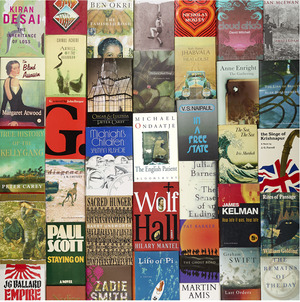Check out what’s coming up at the Morgan Library & Museum:
HISTORY OF ENGLAND’S PRESTIGIOUS MAN BOOKER PRIZE IS THE SUBJECT OF NEW EXHIBITION AT THE MORGAN THIS FALL
Bookermania: 45 Years of the Man Booker Prize
September 13, 2013—January 5, 2014

New York, NY, August 22, 2013—England’s Man Booker Prize turnedPossession into an instant best seller, propelled The English Patientand Life of Pi onto the screen, and made a star out of an advertising copywriter named Salman Rushdie. Throughout its history, it has been a dynamic force in marketing literary fiction, while drawing attention to questions about the critical, popular, and economic influences that shape cultural value and confer prestige. Given annually since 1969 to the “best novel in English” written by a citizen of the Commonwealth of Nations, Republic of Ireland, or Zimbabwe, the prize is now the prototype for literary awards around the world. Never without controversy or a chorus of detractors, the Booker has uniquely captured the British imagination and has helped shape a contemporary canon that reflects the expanded borders of the English-language novel today. Bookermania: 45 Years of the Man Booker Prize, on view September 13, 2013–January 5, 2014, is the first American exhibition to explore the world of this award and how it came to take its place in England’s colorful history of promoting the novel.
Works on view in Bookermania are drawn entirely from the Morgan’s Man Booker Prize collection—a singular archive of more than four thousand items that preserves the convergence of collaborative forces at play in the world of authors, publishing, the book trade, and critical establishment that have made the Booker one of the world’s premiere literary awards. On bookshelves around the gallery, a chronological display of every Booker-winning novel and noted contenders narrates important developments in the prize from 1969 to 2012. Transformations in typography, illustration, and book design over more than four decades of contemporary fiction are documented through an array of dust jackets and related artwork. Also on view are some of the unique artifacts in the collection in the form of proofs, manuscripts, annotated judges’ copies, authors’ correspondence, and publishers’ promotional material that explore key figures and important issues surrounding the prize.
Judges, Writers, Publishers, and Controversies
The objects on view offer insights into the writers, judges, and the memorable controversies associated with the prize. Judging notebooks belonging to critics John Sutherland and Ruth Scurr and books annotated by Rick Gekoski, David Daiches, Hermione Lee, and Robert Macfarlane record their idiosyncratic reactions to some of the most important works of postwar fiction. Letters from noted authors such as Kingsley Amis, Iris Murdoch, John Berger, A. S. Byatt, John Banville, and Hilary Mantel’s annotated copy of Wolf Hall provide humorous, thoughtful, and provocative responses to the prize and to their own works, while manuscripts, corrected galleys, and publisher’s promotional materials document the life of a Booker book and how it has been created, distributed, and promoted at particular moments in time.
The Morgan’s Man Booker Prize Collection
The mania in the exhibition’s title refers not only to the British enthusiasm for its highest literary award but also to thebibliomania reflected in the archive that is the foundation of the Morgan’s Man Booker Prize collection. Acquired by the museum in 2010 as a joint acquisition between the departments of Printed Books and Bindings and Literary and Historical Manuscripts, it comprises more than four thousand items including manuscripts, proofs, first editions, reprints, letters, association copies, judges’ annotations, artworks, translations, bespoke bindings, and ephemeral materials related to the finest works of literary fiction published in England. The collection was assembled over several decades by Peter Straus—a British literary agent, publisher, and bibliophile, who has served on the prize’s management committee and has been called its unofficial bibliographer. Straus’s energetic collecting and his attention to the minutiae of “all things Booker” have earned the archive Iain Sinclair’s description as “a museum of madness.”
History of the Booker
The prize was founded in 1968 to encourage reading and jolt the British book trade out of its lingering postwar recession. Its success is largely due to the men whose professions and personalities who defined its original mission: Tom Maschler of the Publishers’ Association, Martyn Goff of the National Book League, and George Hardinge and John Murphy from the Authors’ Division of the agricultural company Booker McConnell. In 2002, the investment management firm Man assumed sponsorship and the administration of the award passed to the Booker Prize Foundation, chaired by Jonathan Taylor and under the Literary Direction of Ion Trewin.
Each year, the management committee selects a panel of five jurors—critics, academics, novelists and a “general reader”—to consider the more than 120 novels vying for the prize. Extensive deliberations result in a longlist, announced in July, which is further narrowed down to a shortlist of five or six finalists in September. The winner is announced at a nationally televised ceremony in mid-October. The first winning novel in 1969 was P. H. Newby’s Something to Answer For. In 2012, Hilary Mantel won the award for Bring Up the Bodies.
